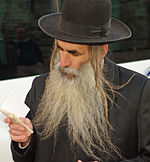Pe'ot

Haredi Jewish man with untrimmed beard and pe'ot
|
|
| Halakhic texts relating to this article | |
|---|---|
| Torah: | Leviticus 19:27 |
| Babylonian Talmud: | Makkot 20a |
| Mishneh Torah: | Avodath Kokhavim 12:6 |
| Shulchan Aruch: | Yoreh Deah 181 |
Payot (Hebrew: פֵּאָה; plural: פֵּאוֹת), also pronounced pe'ot, peyot; or payos, peyos, peyois, payois in Ashkenazi pronunciation, is the Hebrew word for sidelocks or sidecurls. Payot are worn by some men and boys in the Orthodox Jewish community based on an interpretation of the Biblical injunction against shaving the "corners" of one's head. Literally, pe'ah means "corner, side, edge". There are different styles of payot among Haredi, Yemenite, and Hasidic Jews. Yemenite Jews call their sidelocks simonim (סִימָנִים), literally "signs", because their long-curled sidelocks served as a distinguishing feature in the Yemenite society (differentiating them from their non-Jewish neighbors).
The Torah says, "You shall not round off the pe'at (פְּאַת) of your head" (Leviticus 19:27). The word pe'at was taken to mean the hair in front of the ears extending to beneath the cheekbone, on a level with the nose (Talmud – Makkot 20a). The Mishnah interpreted the regulation as applying only to men. Thus it became the custom in certain circles to allow the hair over the ears to grow, and hang down in curls or ringlets. According to Maimonides, shaving the sidelocks was a heathen practice. There is considerable discussion in the halachic literature as to the precise location of the payot and of the ways in which their removal is prohibited.
As kabbalistic teachings spread into Slavonic lands, the custom of payot became accepted there. In 1845 the practice was banned in the Russian Empire.Crimean Karaites did not wear payot, and the Crimean Tatars consequently referred to them as zulufsız çufutlar ("Jews without payot"), to distinguish them from the Krymchaks, referred to as zuluflı çufutlar ("Jews with payot"). Many Hasidic and Yemenite Jews let their sidelocks grow particularly long. Some Haredi men grow sidelocks, but keep them short or tuck them behind the ears. Even among Jewish groups in which the men do not wear noticeable payot, often the young boys do wear them until around the age of bar mitzvah.
...
Wikipedia
